check engine Alfa Romeo 8C 2007 Owner handbook (in English)
[x] Cancel search | Manufacturer: ALFA ROMEO, Model Year: 2007, Model line: 8C, Model: Alfa Romeo 8C 2007Pages: 223, PDF Size: 14.35 MB
Page 5 of 223
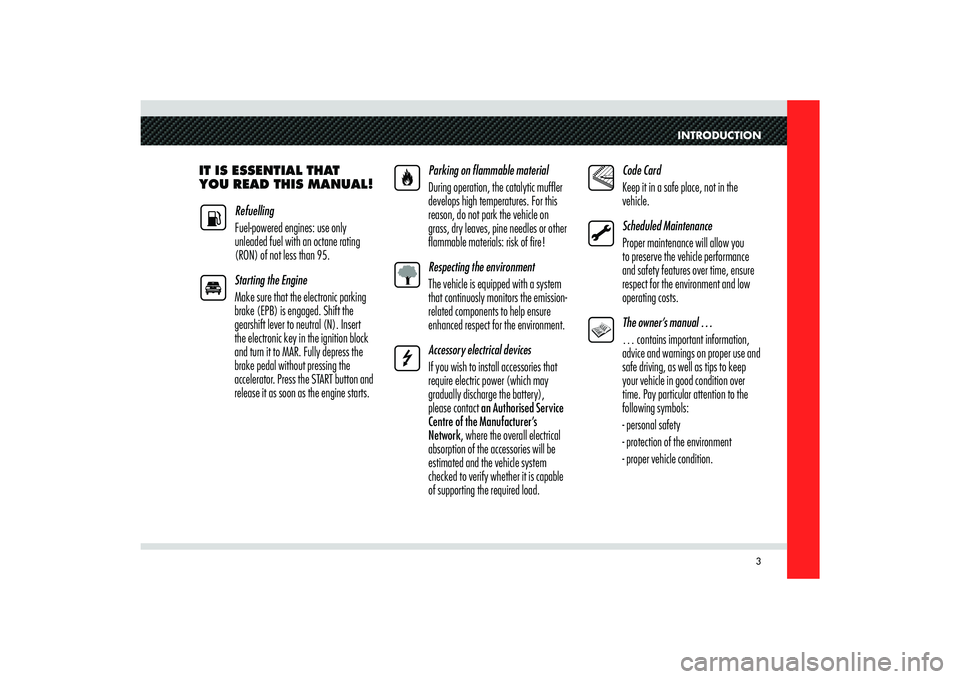
INTRODUCTION
3
IT IS ESSENTIAL THAT
YOU READ THIS MANUAL!
Refuelling
Fuel-powered engines: use only
unleaded fuel with an octane rating
(RON) of not less than 95.
Starting the Engine
Make sure that the electronic parking
brake (EPB) is engaged. Shift the
gearshift lever to neutral (N). Insert
the electronic key in the ignition block
and turn it to MAR. Fully depress the
brake pedal without pressing the
accelerator. Press the START button and
release it as soon as the engine starts.Parking on fl ammable material
During operation, the catalytic muffl er
develops high temperatures. For this
reason, do not park the vehicle on
grass, dry leaves, pine needles or other
fl ammable materials: risk of fi re!
Respecting the environment
The vehicle is equipped with a system
that continuosly monitors the emission-
related components to help ensure
enhanced respect for the environment.
Accessory electrical devices
If you wish to install accessories that
require electric power (which may
gradually discharge the battery),
please contact an Authorised Service
Centre of the Manufacturer’s
Network, where the overall electrical
absorption of the accessories will be
estimated and the vehicle system
checked to verify whether it is capable
of supporting the required load. Code Card
Keep it in a safe place, not in the
vehicle.
Scheduled Maintenance
Proper maintenance will allow you
to preserve the vehicle performance
and safety features over time, ensure
respect for the environment and low
operating costs.
The owner’s manual …
… contains important information,
advice and warnings on proper use and
safe driving, as well as tips to keep
your vehicle in good condition over
time. Pay particular attention to the
following symbols:
- personal safety
- protection of the environment
- proper vehicle condition.
Page 34 of 223

32
2
CAUTION
Always drive keeping your
hands on the steering wheel so that, in
the case of activation, the airbag can
deploy without encountering obstacles
which may cause serious injuries. Do
not drive leaning forward, but keep
your seat back upright to support your
back.
CAUTION
To allow the front airbags to
deploy correctly and with optimal
efficiency, both the driver and the front
passenger must maintain a distance of
at least 25 cm from the steering wheel
and the dashboard.
CAUTION
Do not travel with objects in
your lap, in front of your chest or
holding a pipe, pencil or other object in
your mouth. In the event of a collision
with airbag deployment, these objects
may cause serious injuries.
CAUTION
Note that with the ignition
key inserted and turned to MAR,
even with the engine off, the airbags
may activate even if the vehicle is
stationary, if it is run into by another
vehicle. On the other hand, the airbags
will not activate in the event of a
collision with the vehicle stationary
and the key removed from the ignition
block: failure of the airbags to inflate
in these circumstances is not indicative
of system malfunction.CAUTION
If the vehicle has been subject
to theft or attempted theft, vandalism
or flooding, have the airbag system
checked at an Authorised Service
Centre of the Manufacturer’s Network.
CAUTION
If improper operations are
carried out on the electrical system,
the airbag could be activated, thereby
causing injuries to anyone in the
vicinity.
CAUTION
The airbags do not replace the
seat belts but provide supplementary
protection. Moreover, in the event of
head-on collisions at low speed, side
impacts, rear collisions or overturning,
the passengers are protected only by
the seat belts, which must always be
fastened.
Page 35 of 223
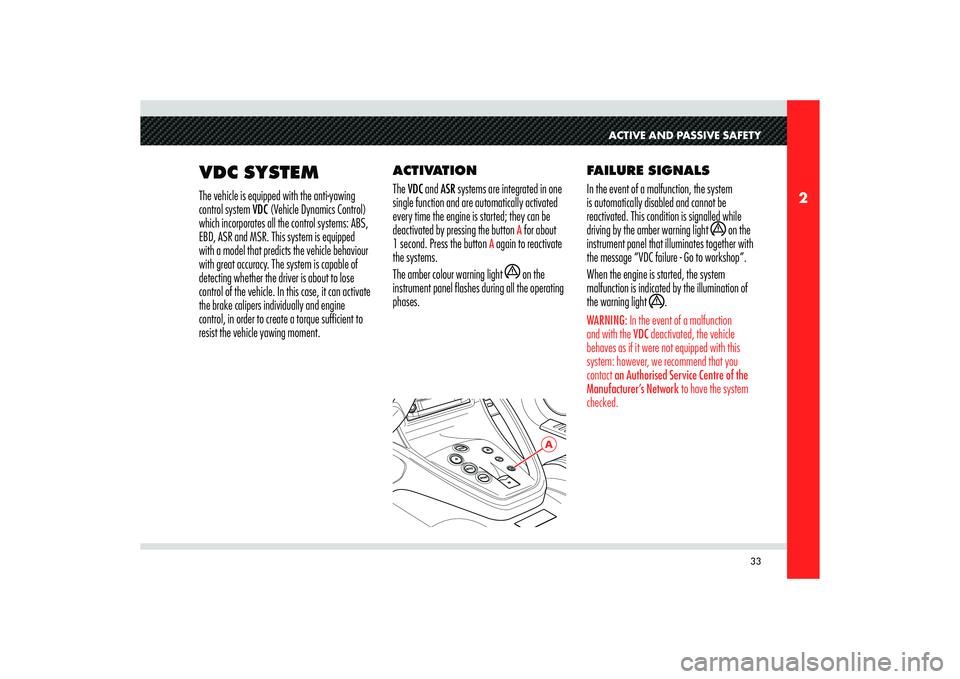
33
2
A
ACTIVE AND PASSIVE SAFETY
VDC SYSTEMThe vehicle is equipped with the anti-yawing
control system VDC (Vehicle Dynamics Control)
which incorporates all the control systems: ABS,
EBD, ASR and MSR. This system is equipped
with a model that predicts the vehicle behaviour
with great accuracy. The system is capable of
detecting whether the driver is about to lose
control of the vehicle. In this case, it can activate
the brake calipers individually and engine
control, in order to create a torque sufficient to
resist the vehicle yawing moment.ACTIVATION
The VDC and ASR systems are integrated in one
single function and are automatically activated
every time the engine is started; they can be
deactivated by pressing the button
A for about
1 second. Press the button
A again to reactivate
the systems.
The amber colour warning light
on the
instrument panel flashes during all the operating
phases.FAILURE SIGNALS
In the event of a malfunction, the system
is automatically disabled and cannot be
reactivated. This condition is signalled while
driving by the amber warning light on the
instrument panel that illuminates together with
the message “VDC failure - Go to workshop”.
When the engine is started, the system
malfunction is indicated by the illumination of
the warning light .
WARNING: In the event of a malfunction
and with the VDC deactivated, the vehicle
behaves as if it were not equipped with this
system: however, we recommend that you
contact an Authorised Service Centre of the
Manufacturer’s Network to have the system
checked.
Page 38 of 223
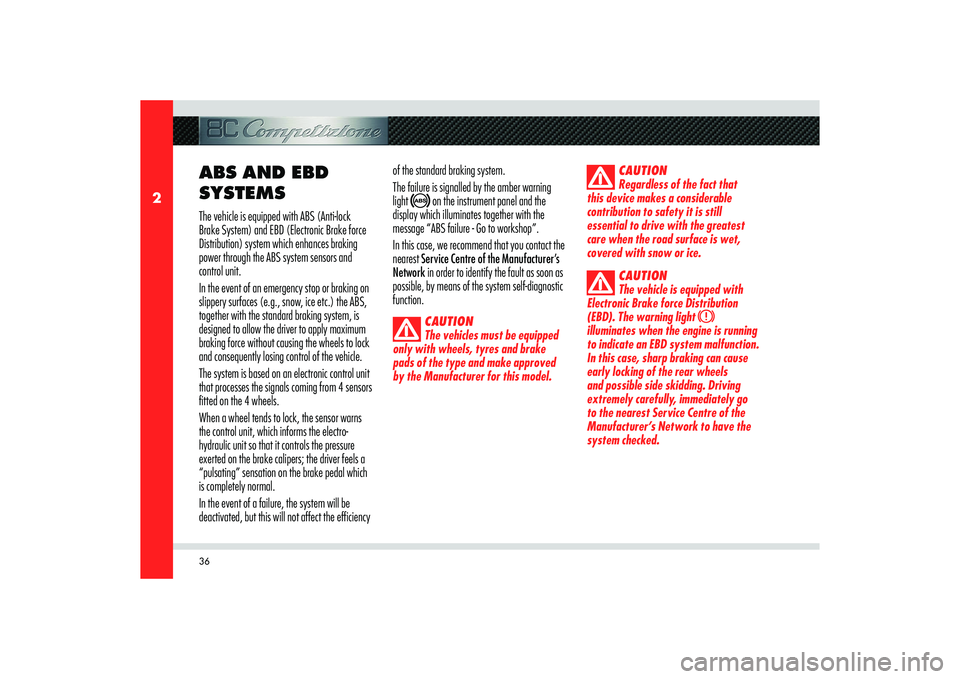
36
2
ABS AND EBD
SYSTEMSThe vehicle is equipped with ABS (Anti-lock
Brake System) and EBD (Electronic Brake force
Distribution) system which enhances braking
power through the ABS system sensors and
control unit.
In the event of an emergency stop or braking on
slippery surfaces (e.g., snow, ice etc.) the ABS,
together with the standard braking system, is
designed to allow the driver to apply maximum
braking force without causing the wheels to lock
and consequently losing control of the vehicle.
The system is based on an electronic control unit
that processes the signals coming from 4 sensors
fitted on the 4 wheels.
When a wheel tends to lock, the sensor warns
the control unit, which informs the electro-
hydraulic unit so that it controls the pressure
exerted on the brake calipers; the driver feels a
“pulsating” sensation on the brake pedal which
is completely normal.
In the event of a failure, the system will be
deactivated, but this will not affect the efficiency of the standard braking system.
The failure is signalled by the amber warning
light
on the instrument panel and the
display which illuminates together with the
message “ABS failure - Go to workshop”.
In this case, we recommend that you contact the
nearest Service Centre of the Manufacturer’s
Network in order to identify the fault as soon as
possible, by means of the system self-diagnostic
function.CAUTION
The vehicles must be equipped
only with wheels, tyres and brake
pads of the type and make approved
by the Manufacturer for this model.CAUTION
Regardless of the fact that
this device makes a considerable
contribution to safety it is still
essential to drive with the greatest
care when the road surface is wet,
covered with snow or ice.
CAUTION
The vehicle is equipped with
Electronic Brake force Distribution
(EBD). The warning light
illuminates when the engine is running
to indicate an EBD system malfunction.
In this case, sharp braking can cause
early locking of the rear wheels
and possible side skidding. Driving
extremely carefully, immediately go
to the nearest Service Centre of the
Manufacturer’s Network to have the
system checked.
Page 39 of 223
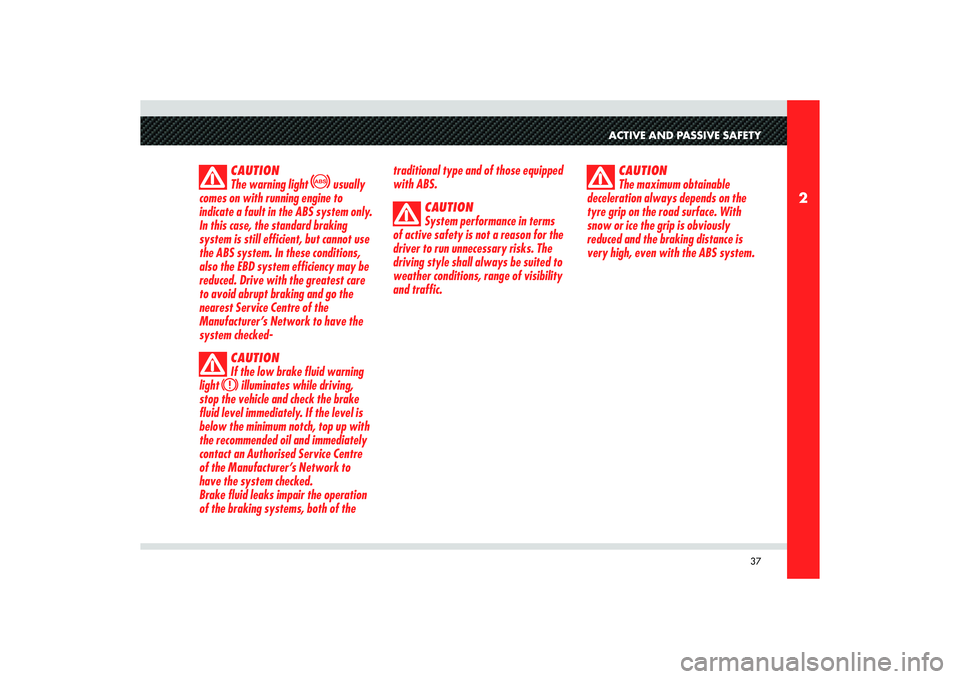
37
2
ACTIVE AND PASSIVE SAFETY
CAUTION
The warning light
usually
comes on with running engine to
indicate a fault in the ABS system only.
In this case, the standard braking
system is still efficient, but cannot use
the ABS system. In these conditions,
also the EBD system efficiency may be
reduced. Drive with the greatest care
to avoid abrupt braking and go the
nearest Service Centre of the
Manufacturer’s Network to have the
system checked-
CAUTION
If the low brake fluid warning
light
illuminates while driving,
stop the vehicle and check the brake
fluid level immediately. If the level is
below the minimum notch, top up with
the recommended oil and immediately
contact an Authorised Service Centre
of the Manufacturer’s Network to
have the system checked.
Brake fluid leaks impair the operation
of the braking systems, both of the
traditional type and of those equipped
with ABS.
CAUTION
System performance in terms
of active safety is not a reason for the
driver to run unnecessary risks. The
driving style shall always be suited to
weather conditions, range of visibility
and traffic.CAUTION
The maximum obtainable
deceleration always depends on the
tyre grip on the road surface. With
snow or ice the grip is obviously
reduced and the braking distance is
very high, even with the ABS system.
Page 40 of 223
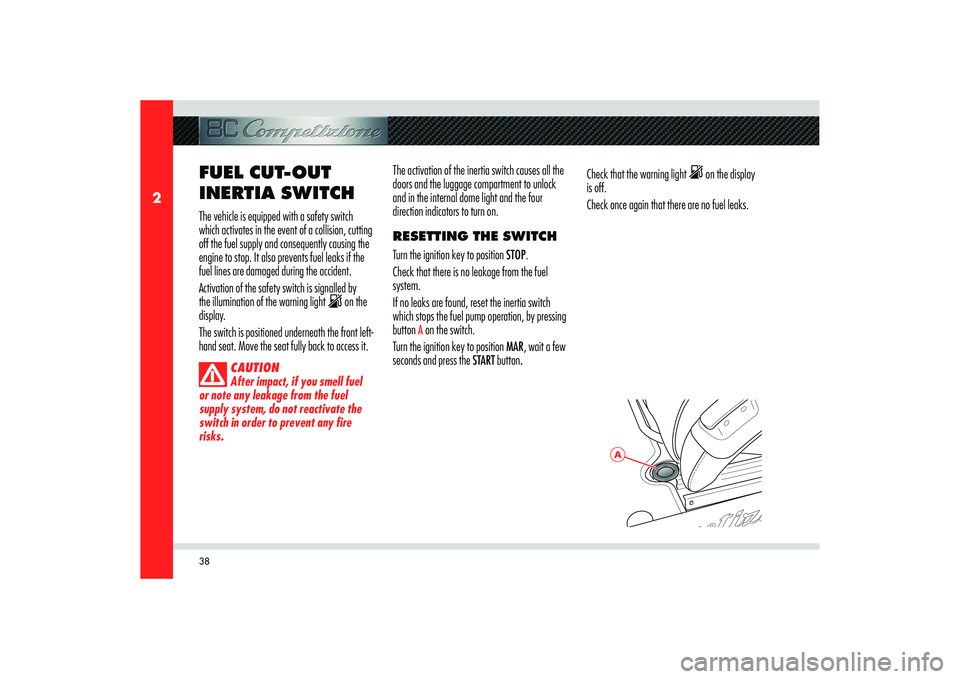
38
2
A
FUEL CUT-OUT
INERTIA SWITCHThe vehicle is equipped with a safety switch
which activates in the event of a collision, cutting
off the fuel supply and consequently causing the
engine to stop. It also prevents fuel leaks if the
fuel lines are damaged during the accident.
Activation of the safety switch is signalled by
the illumination of the warning light
on the
display.
The switch is positioned underneath the front left-
hand seat. Move the seat fully back to access it.
CAUTION
After impact, if you smell fuel
or note any leakage from the fuel
supply system, do not reactivate the
switch in order to prevent any fire
risks.
The activation of the inertia switch causes all the
doors and the luggage compartment to unlock
and in the internal dome light and the four
direction indicators to turn on.
RESETTING THE SWITCH
Turn the ignition key to position STOP.
Check that there is no leakage from the fuel
system.
If no leaks are found, reset the inertia switch
which stops the fuel pump operation, by pressing
button
A on the switch.
Turn the ignition key to position MAR, wait a few
seconds and press the START button.Check that the warning light
on the display
is off.
Check once again that there are no fuel leaks.
Page 63 of 223
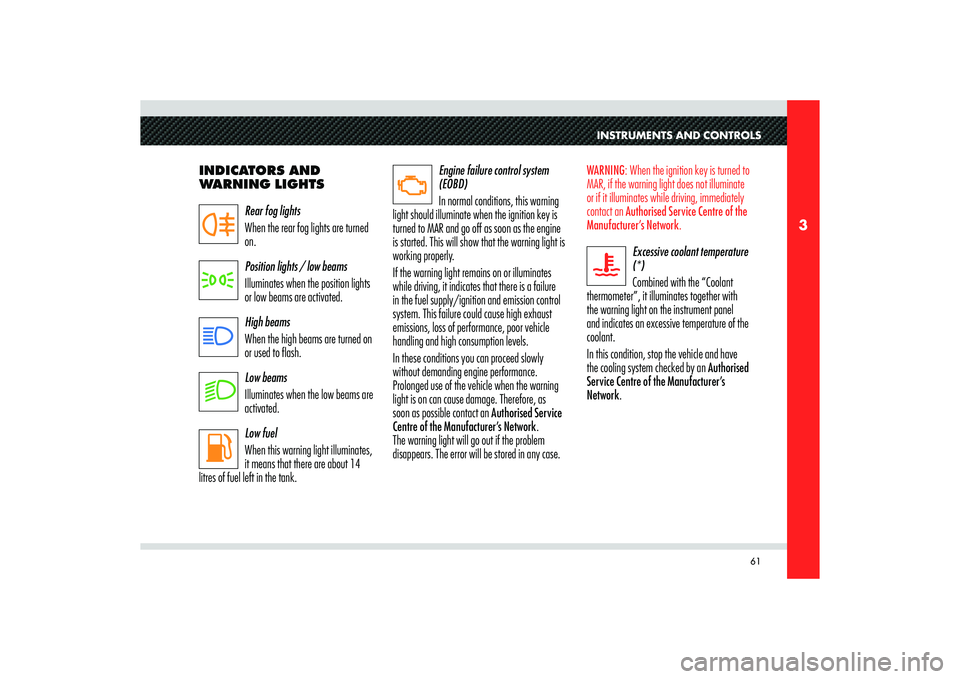
61
3
INSTRUMENTS AND CONTROLSWARNING: When the ignition key is turned to
MAR, if the warning light does not illuminate
or if it illuminates while driving, immediately
contact an Authorised Service Centre of the
Manufacturer’s Network.
Excessive coolant temperature
(*)
Combined with the “Coolant
thermometer”, it illuminates together with
the warning light on the instrument panel
and indicates an excessive temperature of the
coolant.
In this condition, stop the vehicle and have
the cooling system checked by an Authorised
Service Centre of the Manufacturer’s
Network. INDICATORS AND
WARNING LIGHTS
Rear fog lights
When the rear fog lights are turned
on.
Position lights / low beams
Illuminates when the position lights
or low beams are activated.
High beams
When the high beams are turned on
or used to flash.
Low beams
Illuminates when the low beams are
activated.
Low fuel
When this warning light illuminates,
it means that there are about 14
litres of fuel left in the tank.Engine failure control system
(EOBD)
In normal conditions, this warning
light should illuminate when the ignition key is
turned to MAR and go off as soon as the engine
is started. This will show that the warning light is
working properly.
If the warning light remains on or illuminates
while driving, it indicates that there is a failure
in the fuel supply/ignition and emission control
system. This failure could cause high exhaust
emissions, loss of performance, poor vehicle
handling and high consumption levels.
In these conditions you can proceed slowly
without demanding engine performance.
Prolonged use of the vehicle when the warning
light is on can cause damage. Therefore, as
soon as possible contact an Authorised Service
Centre of the Manufacturer’s Network.
The warning light will go out if the problem
disappears. The error will be stored in any case.
Page 64 of 223
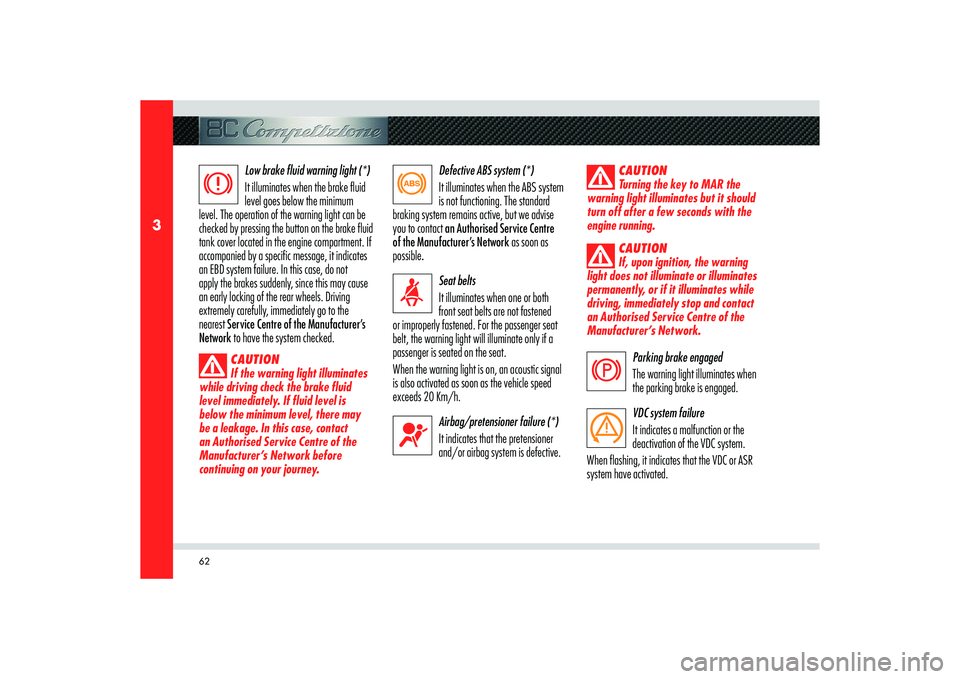
62
3
Low brake fluid warning light (*)
It illuminates when the brake fluid
level goes below the minimum
level. The operation of the warning light can be
checked by pressing the button on the brake fluid
tank cover located in the engine compartment. If
accompanied by a specific message, it indicates
an EBD system failure. In this case, do not
apply the brakes suddenly, since this may cause
an early locking of the rear wheels. Driving
extremely carefully, immediately go to the
nearest Service Centre of the Manufacturer’s
Network to have the system checked.
CAUTION
If the warning light illuminates
while driving check the brake fluid
level immediately. If fluid level is
below the minimum level, there may
be a leakage. In this case, contact
an Authorised Service Centre of the
Manufacturer’s Network before
continuing on your journey.
Defective ABS system (*)
It illuminates when the ABS system
is not functioning. The standard
braking system remains active, but we advise
you to contact an Authorised Service Centre
of the Manufacturer’s Network as soon as
possible.
Seat belts
It illuminates when one or both
front seat belts are not fastened
or improperly fastened. For the passenger seat
belt, the warning light will illuminate only if a
passenger is seated on the seat.
When the warning light is on, an acoustic signal
is also activated as soon as the vehicle speed
exceeds 20 Km/h.
Airbag/pretensioner failure (*)
It indicates that the pretensioner
and/or airbag system is defective.
CAUTION
Turning the key to MAR the
warning light illuminates but it should
turn off after a few seconds with the
engine running.
CAUTION
If, upon ignition, the warning
light does not illuminate or illuminates
permanently, or if it illuminates while
driving, immediately stop and contact
an Authorised Service Centre of the
Manufacturer’s Network.
Parking brake engaged
The warning light illuminates when
the parking brake is engaged.
VDC system failure
It indicates a malfunction or the
deactivation of the VDC system.
When flashing, it indicates that the VDC or ASR
system have activated.
Page 66 of 223
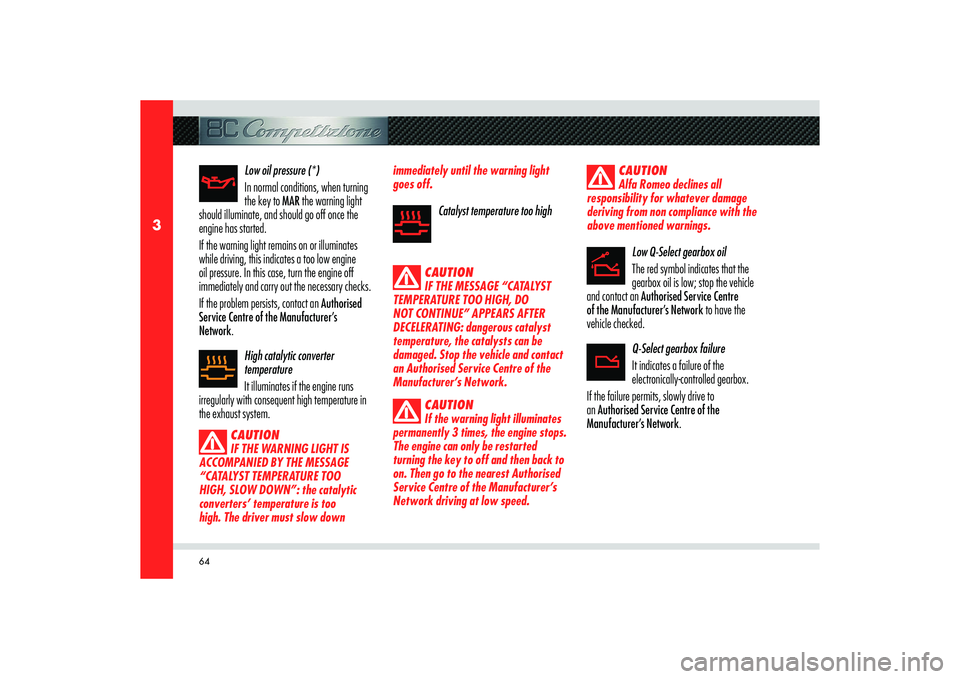
64
3
Low oil pressure (*)
In normal conditions, when turning
the key to MAR the warning light
should illuminate, and should go off once the
engine has started.
If the warning light remains on or illuminates
while driving, this indicates a too low engine
oil pressure. In this case, turn the engine off
immediately and carry out the necessary checks.
If the problem persists, contact an Authorised
Service Centre of the Manufacturer’s
Network.
High catalytic converter
temperature
It illuminates if the engine runs
irregularly with consequent high temperature in
the exhaust system.
CAUTION
IF THE WARNING LIGHT IS
ACCOMPANIED BY THE MESSAGE
“CATALYST TEMPERATURE TOO
HIGH, SLOW DOWN”: the catalytic
converters’ temperature is too
high. The driver must slow down immediately until the warning light
goes off.
Catalyst temperature too high
CAUTION
IF THE MESSAGE “CATALYST
TEMPERATURE TOO HIGH, DO
NOT CONTINUE” APPEARS AFTER
DECELERATING: dangerous catalyst
temperature, the catalysts can be
damaged. Stop the vehicle and contact
an Authorised Service Centre of the
Manufacturer’s Network.
CAUTION
If the warning light illuminates
permanently 3 times, the engine stops.
The engine can only be restarted
turning the key to off and then back to
on. Then go to the nearest Authorised
Service Centre of the Manufacturer’s
Network driving at low speed.CAUTION
Alfa Romeo declines all
responsibility for whatever damage
deriving from non compliance with the
above mentioned warnings.
Low Q-Select gearbox oil
The red symbol indicates that the
gearbox oil is low; stop the vehicle
and contact an Authorised Service Centre
of the Manufacturer’s Network to have the
vehicle checked.
Q-Select gearbox failure
It indicates a failure of the
electronically-controlled gearbox.
If the failure permits, slowly drive to
an Authorised Service Centre of the
Manufacturer’s Network.
Page 83 of 223
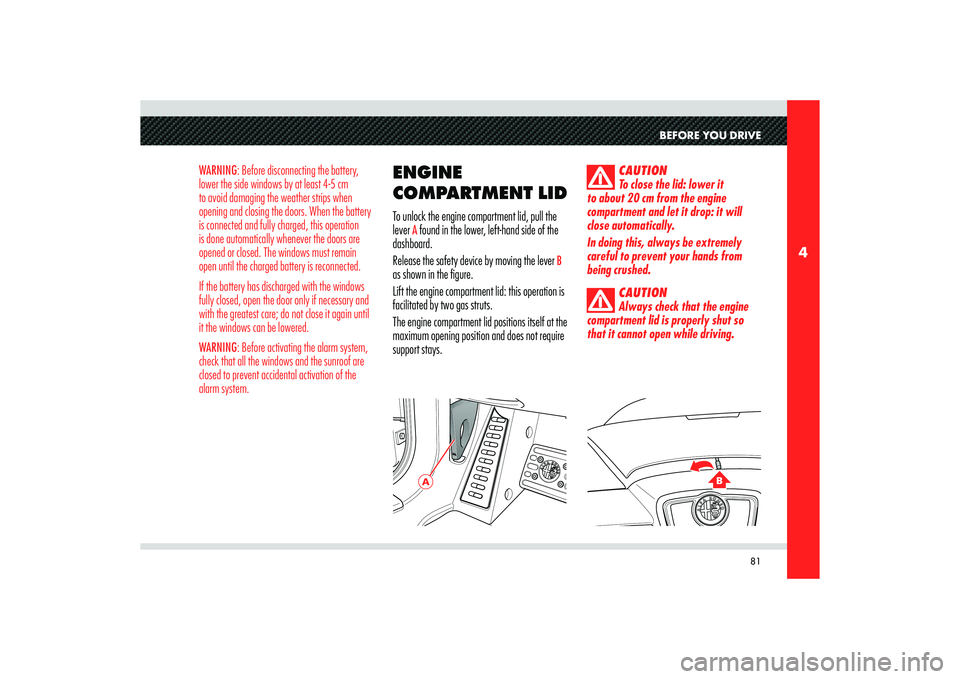
81
4
A
B
BEFORE YOU DRIVE
WARNING: Before disconnecting the battery,
lower the side windows by at least 4-5 cm
to avoid damaging the weather strips when
opening and closing the doors. When the battery
is connected and fully charged, this operation
is done automatically whenever the doors are
opened or closed. The windows must remain
open until the charged battery is reconnected.
If the battery has discharged with the windows
fully closed, open the door only if necessary and
with the greatest care; do not close it again until
it the windows can be lowered.
WARNING: Before activating the alarm system,
check that all the windows and the sunroof are
closed to prevent accidental activation of the
alarm system.
ENGINE
COMPARTMENT LID
To unlock the engine compartment lid, pull the
lever
A found in the lower, left-hand side of the
dashboard.
Release the safety device by moving the lever
B
as shown in the figure.
Lift the engine compartment lid: this operation is
facilitated by two gas struts.
The engine compartment lid positions itself at the
maximum opening position and does not require
support stays.
CAUTION
To close the lid: lower it
to about 20 cm from the engine
compartment and let it drop: it will
close automatically.
In doing this, always be extremely
careful to prevent your hands from
being crushed.
CAUTION
Always check that the engine
compartment lid is properly shut so
that it cannot open while driving.